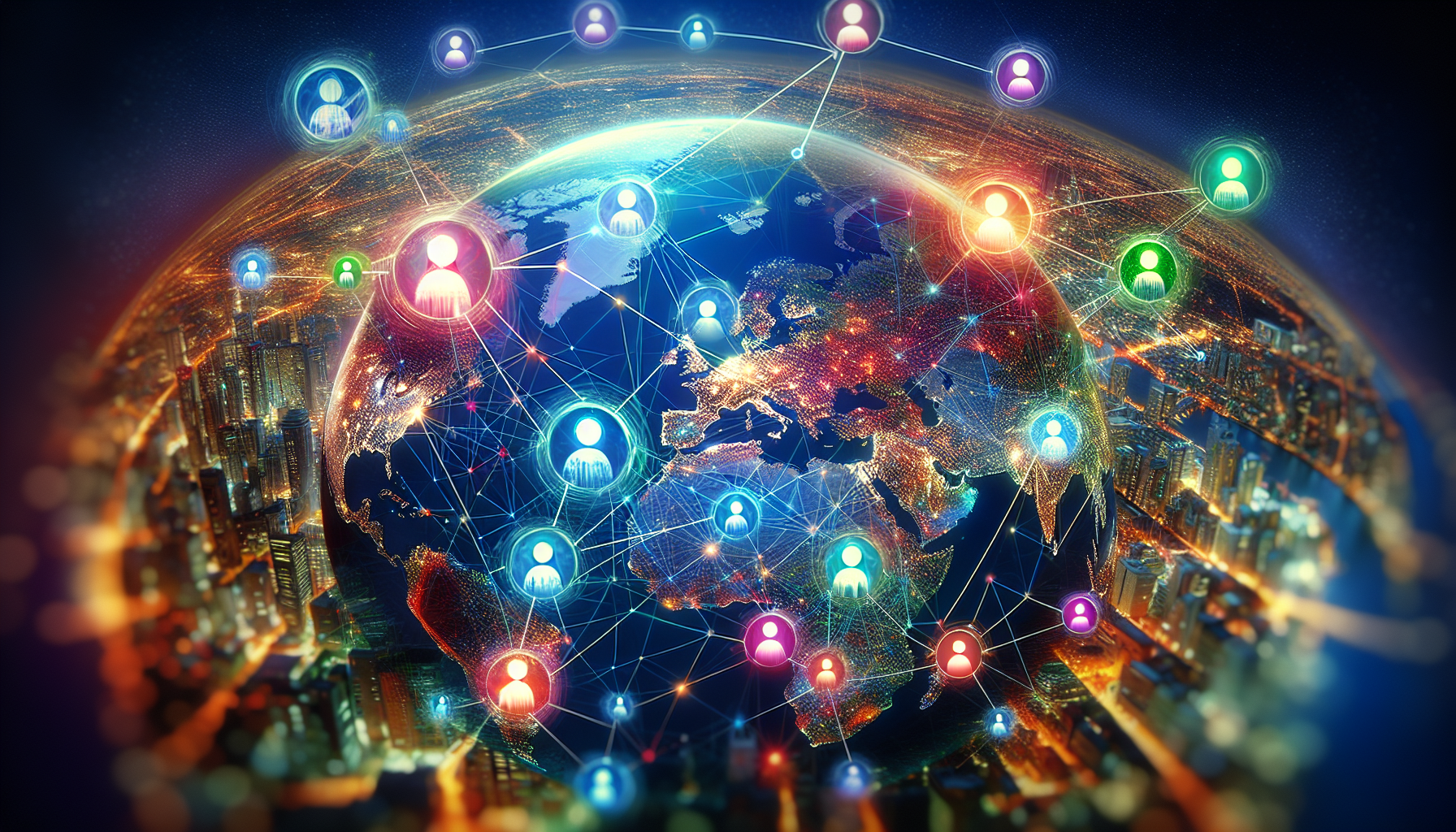The workplace is undergoing a transformation towards a more connected and global work model. As organizations and employees grapple with this shift, questions about managing remote teams, leveraging technology for collaboration, and maintaining well-being in a borderless office come to the forefront. This article breaks down the essential components of a globally connected work environment, examines its challenges and opportunities, and provides practical insights for building a resilient, diverse, and high-performing global workforce.
Key Takeaways
- The workplace is undergoing a significant transformation with a shift towards remote and hybrid work models, which affects business operations, employee experience, and the global economy.
- Remote and hybrid work models are heavily supported by technology, with virtual collaboration tools and cloud computing at the core, enabling worldwide collaboration and secure data access.
- The switch to remote and hybrid work models presents unique challenges to mental health, necessitating a focus on work-life balance, combating burnout, and providing support for employee well-being.
The Shift to Remote and Hybrid Work Models
The workplace as we know it is transforming rapidly. Driven by technological advancements and the Covid-19 pandemic, we are witnessing a massive shift towards remote and hybrid work models. This change is not just about where we work; it is reshaping how we work, with significant implications for employees, businesses, and the global economy.
The Rise of Remote Working
Remote work has revolutionized the way businesses operate. Previously a privilege offered by a handful of innovative companies, the Covid-19 pandemic has accelerated its adoption, making it standard practice for numerous businesses. And it’s not just about working from home; it’s about working from anywhere, giving employees the flexibility to balance their professional and personal lives more effectively.
Embracing Hybrid Work Models
Besides embracing fully remote work, many businesses are also adopting the hybrid model. In fact, more than half of these companies have found that hybrid work represents a balance between office-based and the ability to work remotely, providing employees with the flexibility to engage in working remotely some days and from the office on others.
This flexibility gives office workers the best of both worlds, enabling them to enjoy the social interaction of the physical office space environment while also benefiting from the flexibility of remote work.
Enhancing Global Collaboration Through Technology
The facilitation of remote and hybrid work models heavily relies on technology. From virtual collaboration tools that facilitate real-time communication to cloud computing that provides secure, on-demand access to data and applications, technology is at the heart of the global, connected work environment.

Virtual Collaboration Tools
The foundation of remote and hybrid work environments is laid by virtual collaboration tools. These tools encompass a range of technologies, including:
- Video conferencing platforms
- Messaging platforms
- Virtual whiteboards
- Project management software
These tools enable teams to communicate and collaborate effectively, irrespective of their physical location.
Cloud Computing and Data Analytics
Other technologies instrumental in supporting remote and hybrid work include cloud computing and data analytics. Cloud-based solutions provide secure, real-time access to data and applications, facilitating effective collaboration among geographically dispersed teams.
Data analytics, on the other hand, enables businesses to derive insights from large volumes of data, aiding in decision-making and strategy formulation.
Addressing Mental Health and Well-being in a Connected World
Despite the numerous benefits of remote and hybrid work models, they pose unique challenges to mental health and well-being. The blurred boundaries between work and personal life, the lack of social interaction, and the expectation of being always-on can lead to stress and burnout.
Remote Work Burnout
The prevalence of remote work burnout is escalating in our digital era. With the lines between work and personal life often blurred, remote employees may find themselves working longer hours, leading to increased stress and eventually burnout.
Supporting Employee Well-being
The focus on employee well-being isn’t only about preventing burnout; it also involves fostering an environment conducive to their growth. This involves:
- Providing resources and benefits tailored to the needs of remote and hybrid workers
- Promoting a healthy work-life balance
- Fostering a culture of openness and inclusivity.
Adapting to the Evolving Global Workforce Skills Landscape
The skills landscape is evolving in tandem with the changing world of work. Digitization is driving demand for new skills, while other skills are becoming less relevant. To stay competitive, businesses must adapt by upskilling and reskilling their employees.
The Impact of Digitization on Skills Demands
Digitization deeply influences the demand for skills. As work processes become increasingly digital, there is a growing need for digital skills. But it’s not just about technical skills; the future of work will also require a blend of social and emotional skills, as well as advanced cognitive skills for knowledge workers.
Strategies for Upskilling and Reskilling
A one-size-fits-all strategy doesn’t apply to upskilling and reskilling employees. A custom approach is necessary, considering the distinct needs and goals of each individual.
By providing targeted training and development opportunities, businesses can equip their employees with the skills they need for the future, enabling workers to adapt and grow within their roles.
Navigating Cultural Differences in a Global Work Environment
In our interconnected world, businesses operate globally, spanning across various time zones, languages, and cultures. This diversity brings rich perspectives and ideas, but it also presents challenges in terms of communication and understanding.
Recognizing and Valuing Diversity
Valuing and recognizing diversity goes beyond meeting quotas or ticking boxes. It’s about creating an inclusive environment where everyone’s voice is heard and valued.
Diversity brings fresh ideas, different perspectives, and a wealth of experiences, driving innovation and competitiveness.
Strategies for Cross-Cultural Communication
For global teams to collaborate effectively, cross-cultural communication is crucial. It requires cultural awareness, sensitivity, and flexibility. By understanding and respecting cultural differences, teams can build stronger relationships and work more effectively together.
In conclusion, the world of work is undergoing a paradigm shift. Remote and hybrid work models, powered by technology, are becoming the new norm. While these models offer numerous benefits, they also present unique challenges, particularly in terms of mental health and well-being, skills demands, and cultural differences. Businesses that proactively address these challenges, embrace diversity, and invest in their employees’ development will be best positioned to thrive in the future of work.
Frequently Asked Questions
How do you manage a global workforce?
To manage a global workforce, you should focus on culturally appropriate communication, nonverbal etiquette, religious diversity, laws and regulations, and providing support for English as a second language and linguistic diversity. This will help create an inclusive and effective work environment for employees from diverse backgrounds.
Is remote work going away 2024?
Remote work numbers are expected to remain flat in 2024 and then increase again. Despite some large companies calling workers back to the office, many others are quietly reducing office attendance to cut costs.
What is an example of a global workforce?
A global workforce can include sales staff in different countries, customer service agents across time zones, and remote employees collaborating on global processes. This diverse mix of people work together to ensure the success of the enterprise.
What are the three work models?
The three commonly employed working models are fully remote, office-based, and hybrid. Each one has its own advantages and disadvantages. Fully remote work provides flexibility and global talent access but can lead to work-life balance issues and communication challenges.
What is driving the shift towards remote and hybrid work models?
The shift towards remote and hybrid work models is largely driven by technological advancements, the Covid-19 pandemic, employee preferences for flexibility, and the need for businesses to adapt to changing conditions. These factors have collectively influenced the transformation of work models.




0 Comments